Abstract
Risk assessment is a process often divided into the following steps: a) hazard identification, b) dose-response assessment, c) exposure assessment, and d) risk characterization. Regulatory toxicity studies usually are aimed at providing data for the first two steps. Human case reports, environmental research, and in vitro studies may also be used to identify or to further characterize a toxic hazard. In this report the strengths and limitations of in vitro techniques are discussed in light of their usefulness to identify neurotoxic hazards, as well as for the subsequent dose-response assessment. Because of the complexity of the nervous system, multiple functions of individual cells, and our limited knowledge of biochemical processes involved in neurotoxicity, it is not known how well any in vitro system would recapitulate the in vivo system. Thus, it would be difficult to design an in vitro test battery to replace in vivo test systems. In vitro systems are well suited to the study of biological processes in a more isolated context and have been most successfully used to elucidate mechanisms of toxicity, identify target cells of neurotoxicity, and delineate the development and intricate cellular changes induced by neurotoxicants. Both biochemical and morphological end points can be used, but many of the end points used can be altered by pharmacological actions as well as toxicity. Therefore, for many of these end points it is difficult or impossible to set a criterion that allows one to differentiate between a pharmacological and a neurotoxic effect. For the process of risk assessment such a discrimination is central. Therefore, end points used to determine potential neurotoxicity of a compound have to be carefully selected and evaluated with respect to their potential to discriminate between an adverse neurotoxic effect and a pharmacologic effect. It is obvious that for in vitro neurotoxicity studies the primary end points that can be used are those affected through specific mechanisms of neurotoxicity. For example, in vitro systems may be useful for certain structurally defined compounds and mechanisms of toxicity, such as organophosphorus compounds and delayed neuropathy, for which target cells and the biochemical processes involved in the neurotoxicity are well known. For other compounds and the different types of neurotoxicity, a mechanism of toxicity needs to be identified first. Once identified, by either in vivo or in vitro methods, a system can be developed to detect and to evaluate predictive ability for the type of in vivo neurotoxicity produced. Therefore, in vitro tests have their greatest potential in providing information on basic mechanistic processes in order to refine specific experimental questions to be addressed in the whole animal.
Full text
PDF




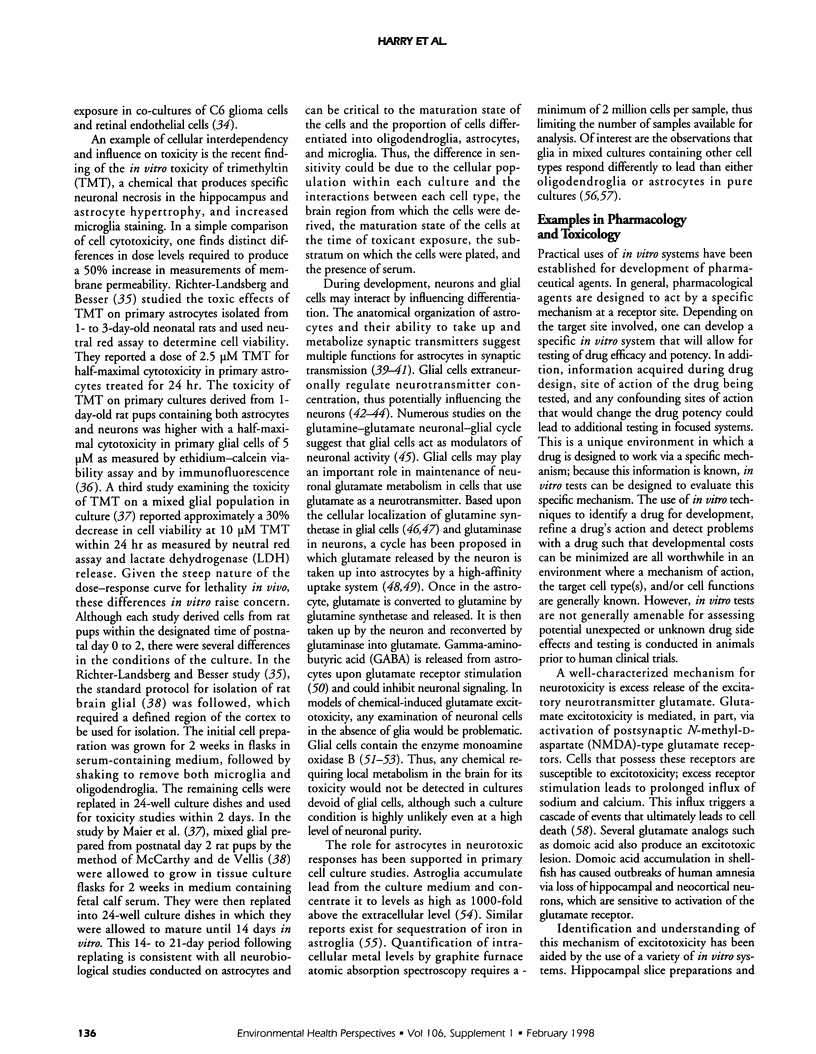
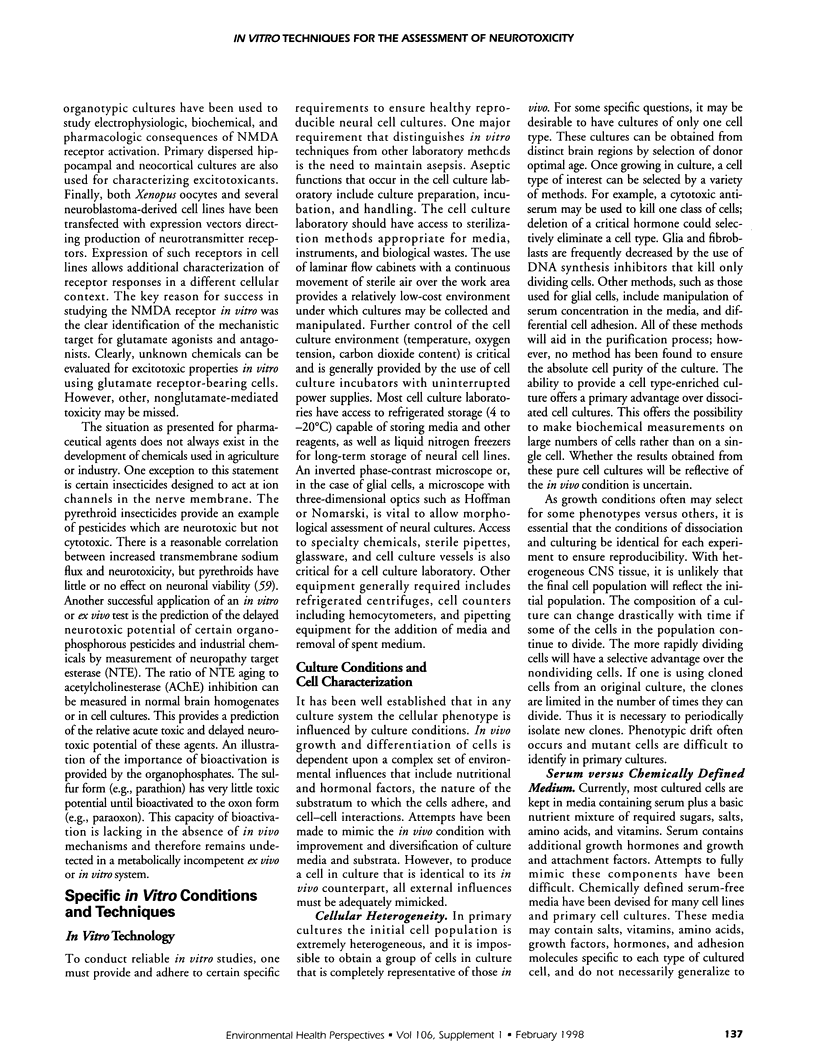







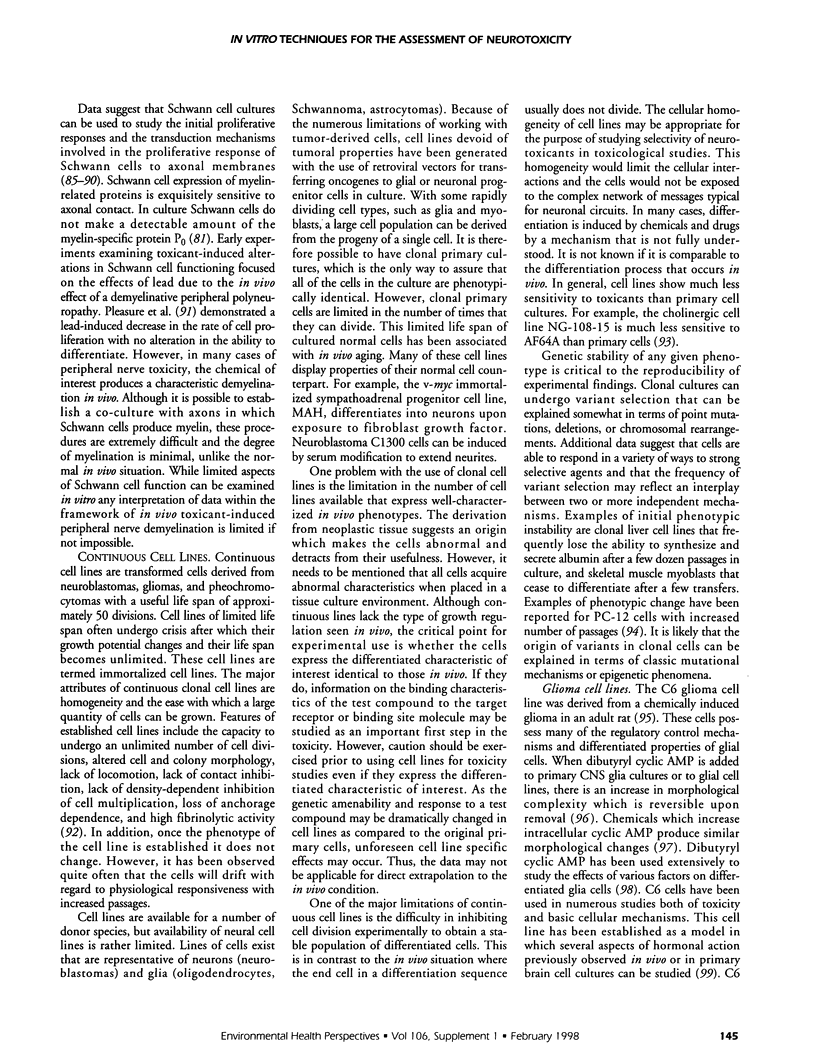

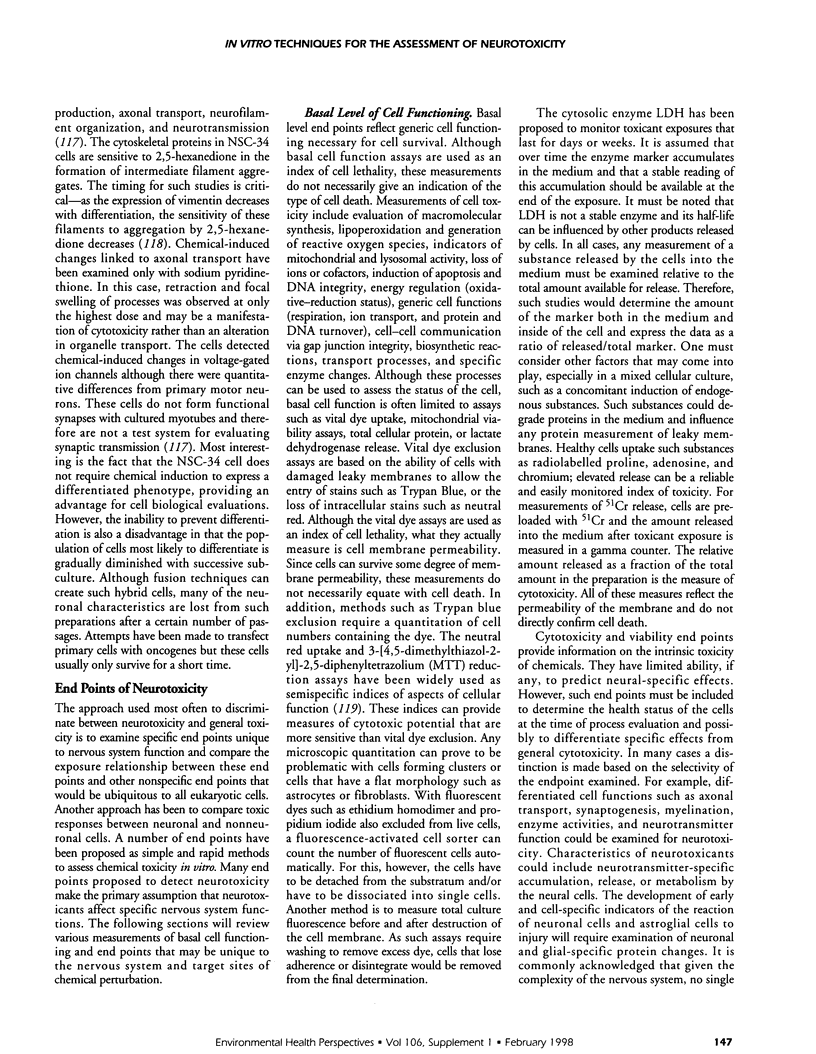
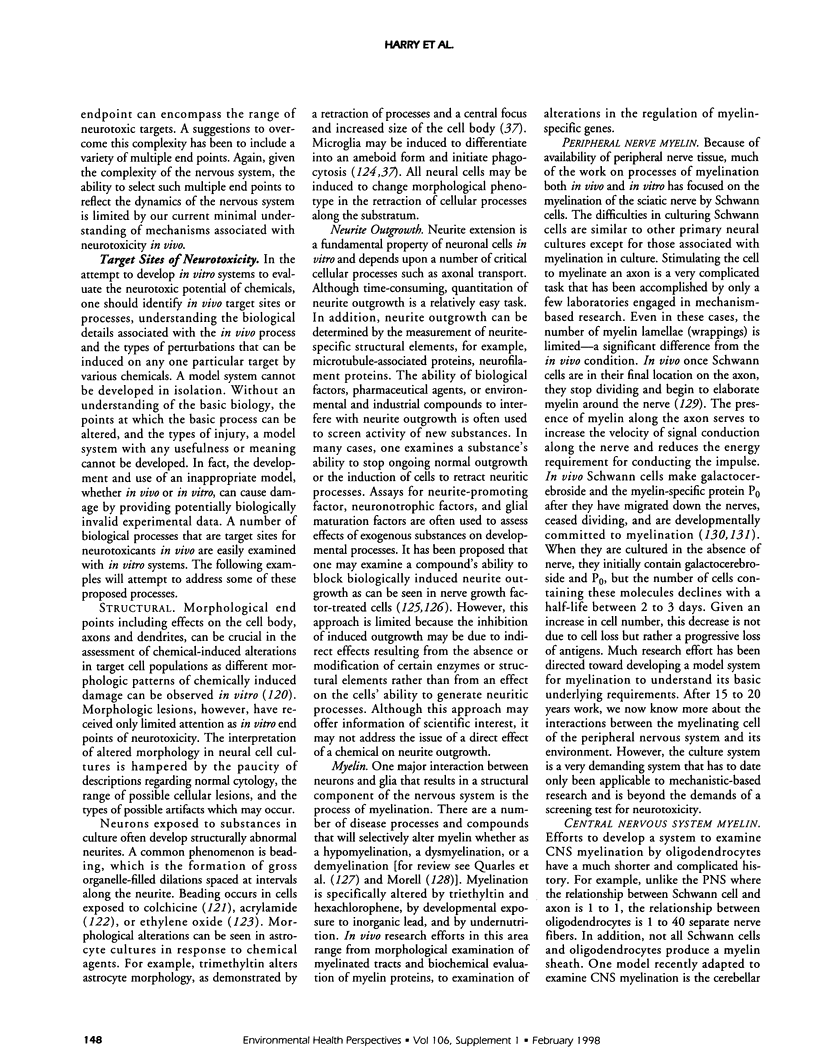
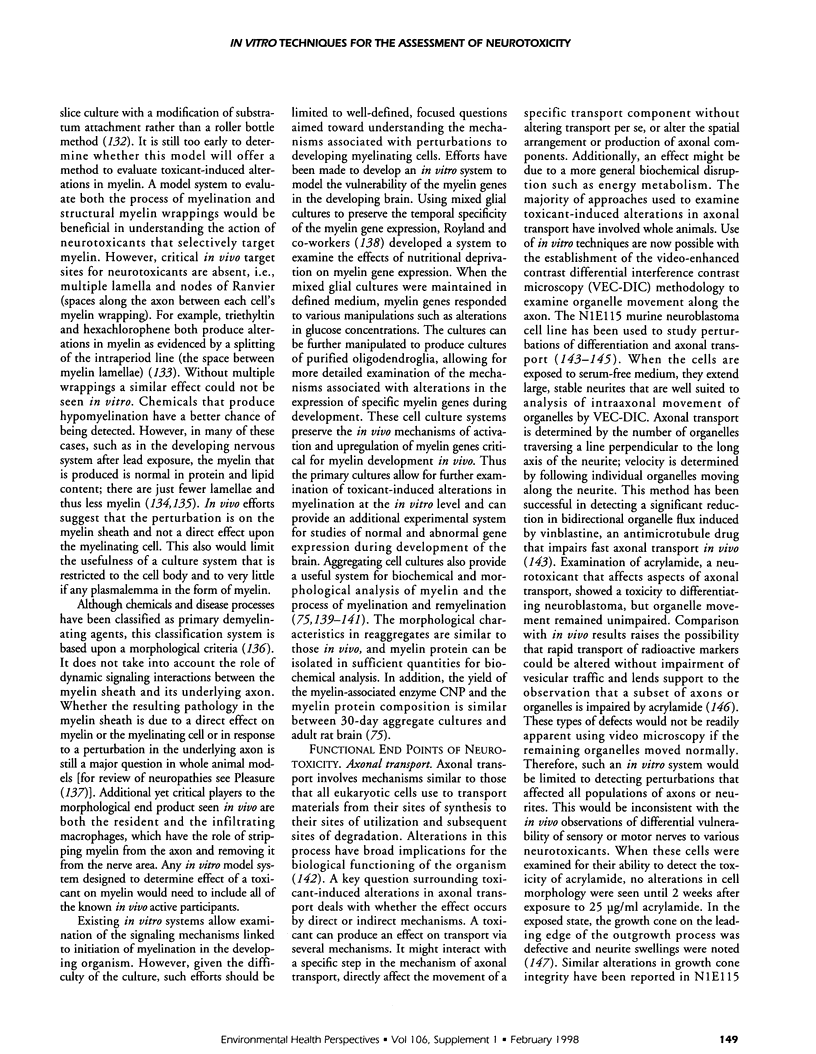
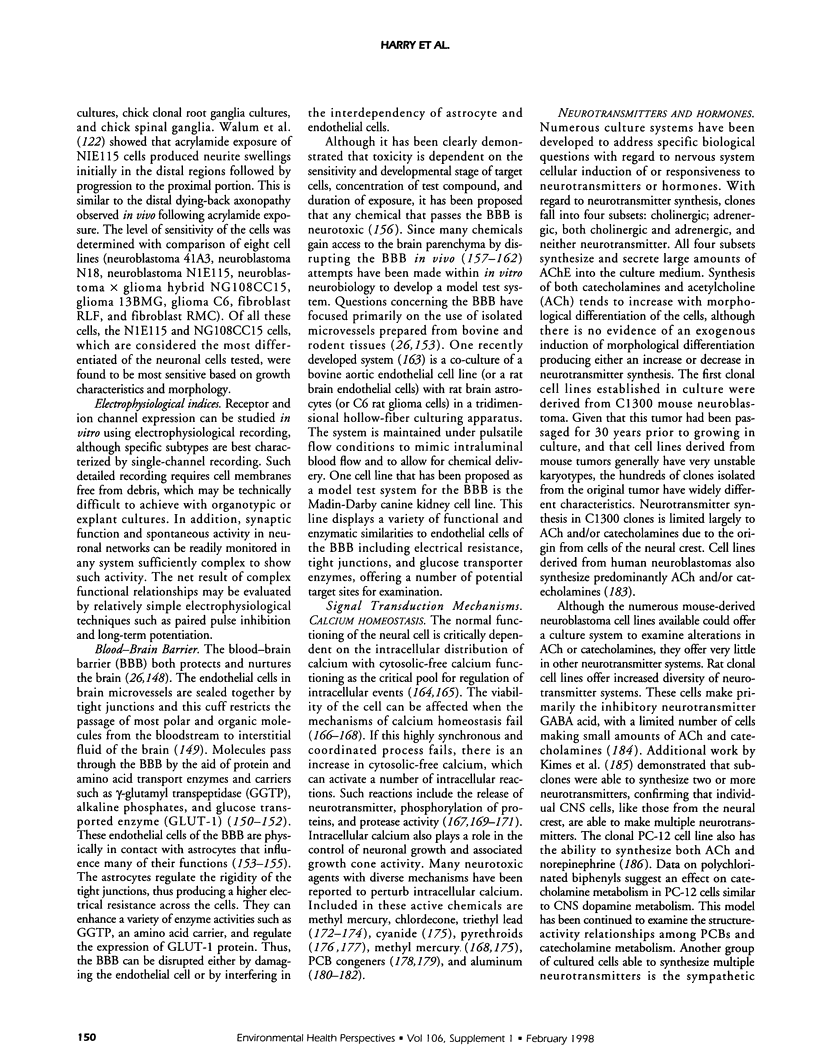

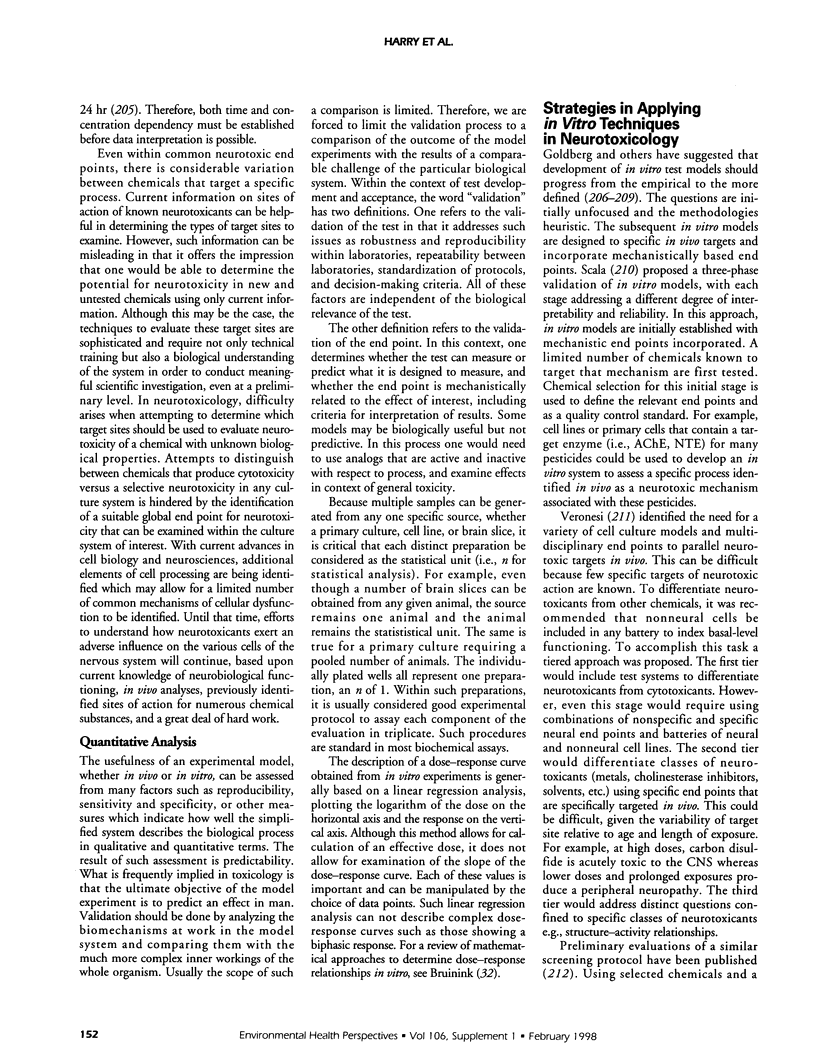
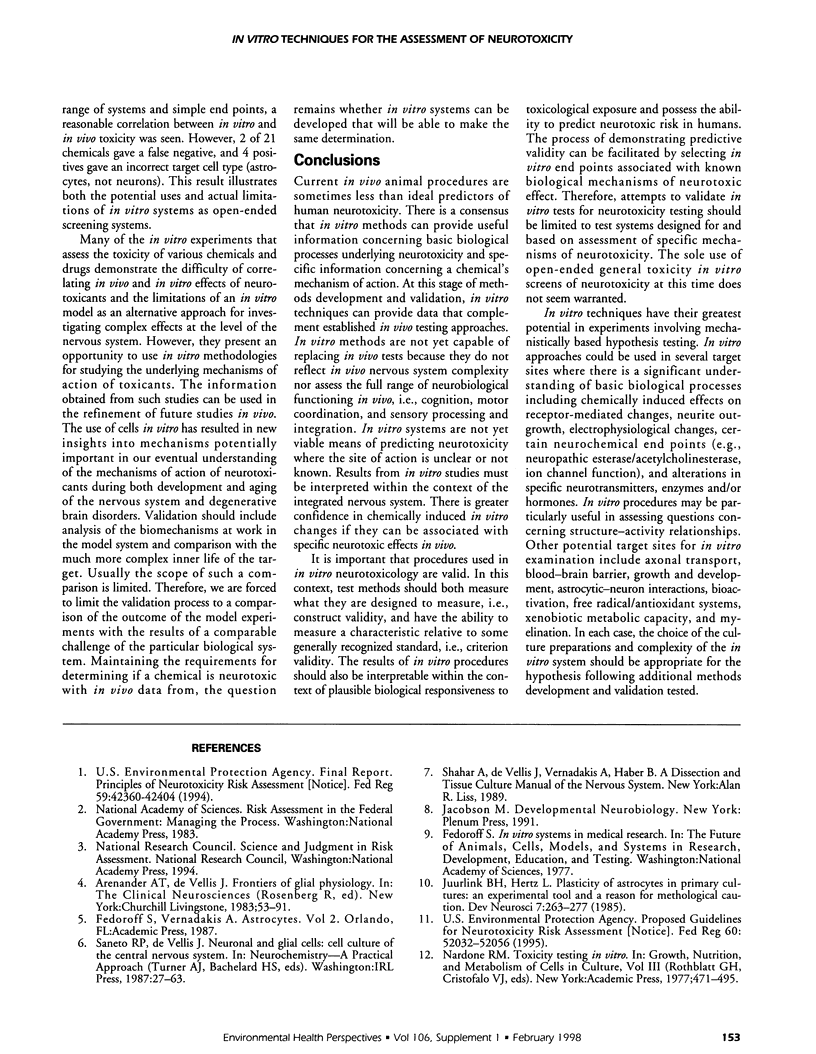




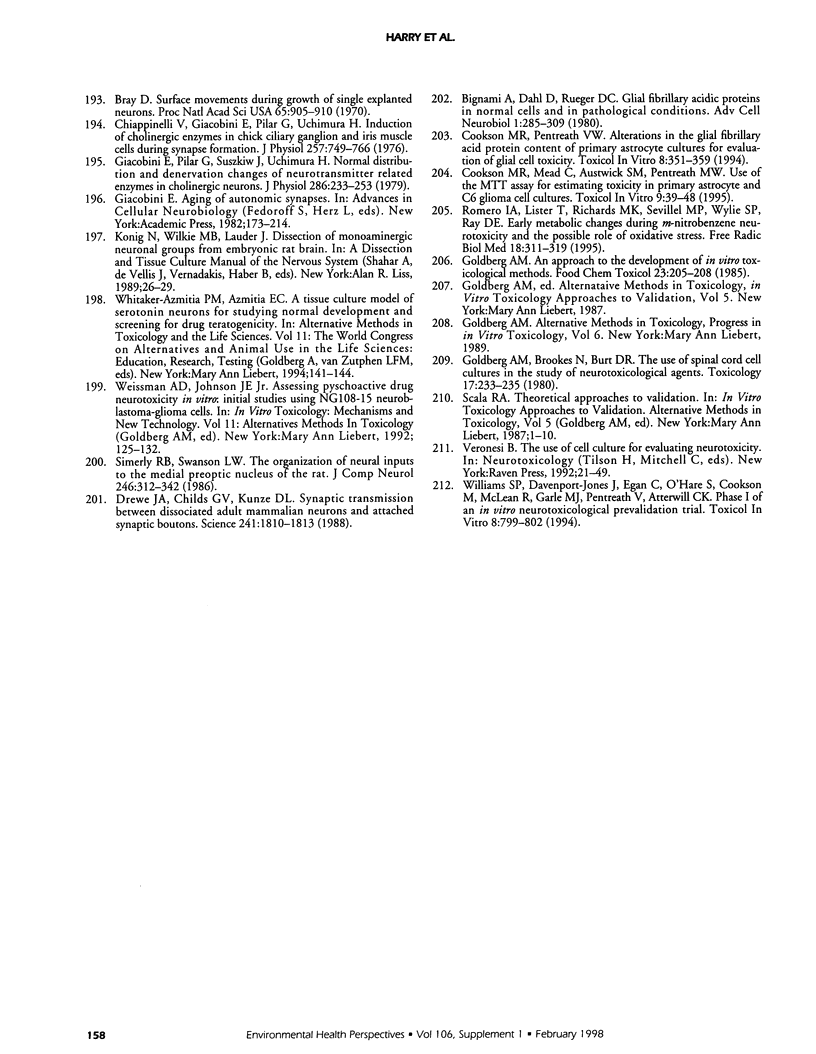
Images in this article
Selected References
These references are in PubMed. This may not be the complete list of references from this article.
- Anghileri L. J. Effects of complexed iron and aluminium on brain calcium. Neurotoxicology. 1992 Summer;13(2):475–478. [PubMed] [Google Scholar]
- Aschner M., Aschner J. L. Mercury neurotoxicity: mechanisms of blood-brain barrier transport. Neurosci Biobehav Rev. 1990 Summer;14(2):169–176. doi: 10.1016/s0149-7634(05)80217-9. [DOI] [PubMed] [Google Scholar]
- Ashani Y., Catravas G. N. Seizure-induced changes in the permeability of the blood-brain barrier following administration of anticholinesterase drugs to rats. Biochem Pharmacol. 1981 Sep 15;30(18):2593–2601. doi: 10.1016/0006-2952(81)90587-6. [DOI] [PubMed] [Google Scholar]
- Atterwill C. K., Johnston H., Thomas S. M. Models for the in vitro assessment of neurotoxicity in the nervous system in relation to xenobiotic and neurotrophic factor-mediated events. Neurotoxicology. 1992 Spring;13(1):39–53. [PubMed] [Google Scholar]
- Balls M., Clothier R. Differentiated cell and organ culture in toxicity testing. Acta Pharmacol Toxicol (Copenh) 1983;52 (Suppl 2):115–137. doi: 10.1111/j.1600-0773.1983.tb02687.x. [DOI] [PubMed] [Google Scholar]
- Benda P., Lightbody J., Sato G., Levine L., Sweet W. Differentiated rat glial cell strain in tissue culture. Science. 1968 Jul 26;161(3839):370–371. doi: 10.1126/science.161.3839.370. [DOI] [PubMed] [Google Scholar]
- Bolon B., Dorman D. C., Bonnefoi M. S., Randall H. W., Morgan K. T. Histopathologic approaches to chemical toxicity using primary cultures of dissociated neural cells grown in chamber slides. Toxicol Pathol. 1993 Sep-Oct;21(5):465–479. doi: 10.1177/019262339302100506. [DOI] [PubMed] [Google Scholar]
- Bowery N. G., Brown D. A., Collins G. G., Galvan M., Marsh S., Yamini G. Indirect effects of amino-acids on sympathetic ganglion cells mediated through the release of gamma-aminobutyric acid from glial cells. Br J Pharmacol. 1976 May;57(1):73–91. doi: 10.1111/j.1476-5381.1976.tb07658.x. [DOI] [PMC free article] [PubMed] [Google Scholar]
- Bradbury M. W., Lightman S. L. The blood-brain interface. Eye (Lond) 1990;4(Pt 2):249–254. doi: 10.1038/eye.1990.36. [DOI] [PubMed] [Google Scholar]
- Brat D. J., Brimijoin S. A paradigm for examining toxicant effects on viability, structure, and axonal transport of neurons in culture. Mol Neurobiol. 1992 Summer-Fall;6(2-3):125–135. doi: 10.1007/BF02780548. [DOI] [PubMed] [Google Scholar]
- Brat D. J., Windebank A. J., Brimijoin S. Emulsifier for intravenous cyclosporin inhibits neurite outgrowth, causes deficits in rapid axonal transport and leads to structural abnormalities in differentiating N1E.115 neuroblastoma. J Pharmacol Exp Ther. 1992 May;261(2):803–810. [PubMed] [Google Scholar]
- Bray D. Surface movements during the growth of single explanted neurons. Proc Natl Acad Sci U S A. 1970 Apr;65(4):905–910. doi: 10.1073/pnas.65.4.905. [DOI] [PMC free article] [PubMed] [Google Scholar]
- Bressler J. P., Goldstein G. W. Mechanisms of lead neurotoxicity. Biochem Pharmacol. 1991 Feb 15;41(4):479–484. doi: 10.1016/0006-2952(91)90617-e. [DOI] [PubMed] [Google Scholar]
- Brockes J. P., Fields K. L., Raff M. C. Studies on cultured rat Schwann cells. I. Establishment of purified populations from cultures of peripheral nerve. Brain Res. 1979 Apr 6;165(1):105–118. doi: 10.1016/0006-8993(79)90048-9. [DOI] [PubMed] [Google Scholar]
- Brookes N., Kristt D. A. Inhibition of amino acid transport and protein synthesis by HgCl2 and methylmercury in astrocytes: selectivity and reversibility. J Neurochem. 1989 Oct;53(4):1228–1237. doi: 10.1111/j.1471-4159.1989.tb07419.x. [DOI] [PubMed] [Google Scholar]
- Browning M. D., Huganir R., Greengard P. Protein phosphorylation and neuronal function. J Neurochem. 1985 Jul;45(1):11–23. doi: 10.1111/j.1471-4159.1985.tb05468.x. [DOI] [PubMed] [Google Scholar]
- Bruinink A., Reiser P. Ontogeny of MAP2 and GFAP antigens in primary cultures of embryonic chick brain. Effect of substratum, oxygen tension, serum and Ara-C. Int J Dev Neurosci. 1991;9(3):269–279. doi: 10.1016/0736-5748(91)90047-p. [DOI] [PubMed] [Google Scholar]
- Bunge R., Johnson M., Ross C. D. Nature and nurture in development of the autonomic neuron. Science. 1978 Mar 31;199(4336):1409–1416. doi: 10.1126/science.24273. [DOI] [PubMed] [Google Scholar]
- Cammer W. Glutamine synthetase in the central nervous system is not confined to astrocytes. J Neuroimmunol. 1990 Feb;26(2):173–178. doi: 10.1016/0165-5728(90)90088-5. [DOI] [PubMed] [Google Scholar]
- Campenot R. B. Local control of neurite development by nerve growth factor. Proc Natl Acad Sci U S A. 1977 Oct;74(10):4516–4519. doi: 10.1073/pnas.74.10.4516. [DOI] [PMC free article] [PubMed] [Google Scholar]
- Chiappinelli V., Giacobini E., Pilar G., Uchimura H. Induction of cholinergic enzymes in chick ciliary ganglion and iris muscle cells during synapse formation. J Physiol. 1976 Jun;257(3):749–766. doi: 10.1113/jphysiol.1976.sp011395. [DOI] [PMC free article] [PubMed] [Google Scholar]
- Choi D. W. Glutamate neurotoxicity in cortical cell culture is calcium dependent. Neurosci Lett. 1985 Aug 5;58(3):293–297. doi: 10.1016/0304-3940(85)90069-2. [DOI] [PubMed] [Google Scholar]
- Choi D. W., Rothman S. M. The role of glutamate neurotoxicity in hypoxic-ischemic neuronal death. Annu Rev Neurosci. 1990;13:171–182. doi: 10.1146/annurev.ne.13.030190.001131. [DOI] [PubMed] [Google Scholar]
- DESMEDT J. E., LA GRUTTA G. The effect of selective inhibition of pseudocholinesterase on the spontaneous and evoked activity of the cat's cerebral cortex. J Physiol. 1957 Apr 3;136(1):20–40. doi: 10.1113/jphysiol.1957.sp005741. [DOI] [PMC free article] [PubMed] [Google Scholar]
- Dahms N. M., Schnaar R. L. Ganglioside composition is regulated during differentiation in the neuroblastoma X glioma hybrid cell line NG108-15. J Neurosci. 1983 Apr;3(4):806–817. doi: 10.1523/JNEUROSCI.03-04-00806.1983. [DOI] [PMC free article] [PubMed] [Google Scholar]
- Dawis S., Hofmann H., Niemeyer G. The electroretinogram, standing potential, and light peak of the perfused cat eye during acid-base changes. Vision Res. 1985;25(9):1163–1177. doi: 10.1016/0042-6989(85)90030-6. [DOI] [PubMed] [Google Scholar]
- DeBault L. E., Cancilla P. A. Induction of gamma-glutamyl transpeptidase in isolated cerebral endothelial cells. Adv Exp Med Biol. 1980;131:79–88. doi: 10.1007/978-1-4684-3752-2_7. [DOI] [PubMed] [Google Scholar]
- DeLong G. R. Histogenesis of fetal mouse isocortex and hippocampus in reaggregating cell cultures. Dev Biol. 1970 Aug;22(4):563–583. doi: 10.1016/0012-1606(70)90169-7. [DOI] [PubMed] [Google Scholar]
- DeVries G. H., Salzer J. L., Bunge R. P. Axolemma-enriched fractions isolated from PNS and CNS are mitogenic for cultured Schwann cells. Brain Res. 1982 Feb;255(2):295–299. doi: 10.1016/0165-3806(82)90028-1. [DOI] [PubMed] [Google Scholar]
- Drapeau P., Blaustein M. P. Initial release of [3H]dopamine from rat striatal synaptosomes: correlation with calcium entry. J Neurosci. 1983 Apr;3(4):703–713. doi: 10.1523/JNEUROSCI.03-04-00703.1983. [DOI] [PMC free article] [PubMed] [Google Scholar]
- Drewe J. A., Childs G. V., Kunze D. L. Synaptic transmission between dissociated adult mammalian neurons and attached synaptic boutons. Science. 1988 Sep 30;241(4874):1810–1813. doi: 10.1126/science.2459774. [DOI] [PubMed] [Google Scholar]
- Durham H. D. 2,5-hexanedione aggregates vimentin-, but not keratin-, intermediate filaments of PtK1 cells. Cell Biol Int Rep. 1987 Apr;11(4):307–318. doi: 10.1016/0309-1651(87)90092-0. [DOI] [PubMed] [Google Scholar]
- Durham H. D., Dahrouge S., Cashman N. R. Evaluation of the spinal cord neuron X neuroblastoma hybrid cell line NSC-34 as a model for neurotoxicity testing. Neurotoxicology. 1993 Winter;14(4):387–395. [PubMed] [Google Scholar]
- Edström A., Kanje M., Löfgren P., Walum E. Drug-induced alterations in morphology and level of cAMP in cultured human glioma cells. Exp Cell Res. 1975 Oct 15;95(2):359–364. doi: 10.1016/0014-4827(75)90561-3. [DOI] [PubMed] [Google Scholar]
- Erecińska M., Silver I. A. Metabolism and role of glutamate in mammalian brain. Prog Neurobiol. 1990;35(4):245–296. doi: 10.1016/0301-0082(90)90013-7. [DOI] [PubMed] [Google Scholar]
- Erkell L. J., Walum E. Differentiation of cultured neuroblastoma cells by urea derivatives. FEBS Lett. 1979 Aug 15;104(2):401–404. doi: 10.1016/0014-5793(79)80862-5. [DOI] [PubMed] [Google Scholar]
- Farber J. L. The role of calcium in lethal cell injury. Chem Res Toxicol. 1990 Nov-Dec;3(6):503–508. doi: 10.1021/tx00018a003. [DOI] [PubMed] [Google Scholar]
- Flott B., Seifert W. Characterization of glutamate uptake systems in astrocyte primary cultures from rat brain. Glia. 1991;4(3):293–304. doi: 10.1002/glia.440040307. [DOI] [PubMed] [Google Scholar]
- Fontana A., Grieder A., Arrenbrecht S., Grob P. In vitro stimulation of glia cells by a lymphocyte-produced factor. J Neurol Sci. 1980 Apr;46(1):55–62. doi: 10.1016/0022-510x(80)90043-x. [DOI] [PubMed] [Google Scholar]
- Fountain S. B., Teyler T. J. Characterizing neurotoxicity using the in vitro hippocampal brain slice preparation: heavy metals. Prog Clin Biol Res. 1987;253:19–31. [PubMed] [Google Scholar]
- Fujita K., Lazarovici P., Guroff G. Regulation of the differentiation of PC12 pheochromocytoma cells. Environ Health Perspect. 1989 Mar;80:127–142. doi: 10.1289/ehp.8980127. [DOI] [PMC free article] [PubMed] [Google Scholar]
- Furshpan E. J., Potter D. D., Landis S. C. On the transmitter repertoire of sympathetic neurons in culture. Harvey Lect. 1980;76:149–191. [PubMed] [Google Scholar]
- Gallo V., Giovannini C., Suergiu R., Levi G. Expression of excitatory amino acid receptors by cerebellar cells of the type-2 astrocyte cell lineage. J Neurochem. 1989 Jan;52(1):1–9. doi: 10.1111/j.1471-4159.1989.tb10890.x. [DOI] [PubMed] [Google Scholar]
- Garnaas K. R., Windebank A. J., Blexrud M. D., Kurtz S. B. Ultrastructural changes produced in dorsal root ganglia in vitro by exposure to ethylene oxide from hemodialyzers. J Neuropathol Exp Neurol. 1991 May;50(3):256–262. doi: 10.1097/00005072-199105000-00007. [DOI] [PubMed] [Google Scholar]
- Gebhart A. M., Goldstein G. W. Use of an in vitro system to study the effects of lead on astrocyte-endothelial cell interactions: a model for studying toxic injury to the blood-brain barrier. Toxicol Appl Pharmacol. 1988 Jun 30;94(2):191–206. doi: 10.1016/0041-008x(88)90261-x. [DOI] [PubMed] [Google Scholar]
- Giacobini E., Pilar G., Suszkiw J., Uchimura H. Normal distribution and denervation changes of neurotransmitter related enzymes in cholinergic neurones. J Physiol. 1979 Jan;286:233–253. doi: 10.1113/jphysiol.1979.sp012616. [DOI] [PMC free article] [PubMed] [Google Scholar]
- Goldberg A. M. An approach to the development of in vitro toxicological methods. Food Chem Toxicol. 1985 Feb;23(2):205–208. doi: 10.1016/0278-6915(85)90018-3. [DOI] [PubMed] [Google Scholar]
- Goldberg A. M., Brookes N., Burt D. R. The use of spinal cord cell cultures in the study of neurotoxicological agents. Toxicology. 1980;17(2):233–235. doi: 10.1016/0300-483x(80)90099-2. [DOI] [PubMed] [Google Scholar]
- Greene L. A., Rein G. Synthesis, storage and release of acetylcholine by a noradrenergic pheochromocytoma cell line. Nature. 1977 Jul 28;268(5618):349–351. doi: 10.1038/268349a0. [DOI] [PubMed] [Google Scholar]
- Greene L. A., Tischler A. S. Establishment of a noradrenergic clonal line of rat adrenal pheochromocytoma cells which respond to nerve growth factor. Proc Natl Acad Sci U S A. 1976 Jul;73(7):2424–2428. doi: 10.1073/pnas.73.7.2424. [DOI] [PMC free article] [PubMed] [Google Scholar]
- Grisham J. W., Smith G. J. Predictive and mechanistic evaluation to toxic responses in mammalian cell culture systems. Pharmacol Rev. 1984 Jun;36(2 Suppl):151S–171S. [PubMed] [Google Scholar]
- Grubinska B., Laszkiewicz I., Royland J., Wiggins R. C., Konat G. W. Differentiation-specific demethylation of myelin associated glycoprotein gene in cultured oligodendrocytes. J Neurosci Res. 1994 Oct 15;39(3):233–242. doi: 10.1002/jnr.490390302. [DOI] [PubMed] [Google Scholar]
- Hamberger A., Nyström B., Sellström A., Woiler C. T. Amino acid transport in isolated neurons and glia. Adv Exp Med Biol. 1976;69:221–236. doi: 10.1007/978-1-4684-3264-0_17. [DOI] [PubMed] [Google Scholar]
- Hamprecht B. Structural, electrophysiological, biochemical, and pharmacological properties of neuroblastoma-glioma cell hybrids in cell culture. Int Rev Cytol. 1977;49:99–170. doi: 10.1016/s0074-7696(08)61948-8. [DOI] [PubMed] [Google Scholar]
- Harry G. J., Morell P., Bouldin T. W. Acrylamide exposure preferentially impairs axonal transport of glycoproteins in myelinated axons. J Neurosci Res. 1992 Mar;31(3):554–560. doi: 10.1002/jnr.490310320. [DOI] [PubMed] [Google Scholar]
- Hatten M. E. Neuronal inhibition of astroglial cell proliferation is membrane mediated. J Cell Biol. 1987 May;104(5):1353–1360. doi: 10.1083/jcb.104.5.1353. [DOI] [PMC free article] [PubMed] [Google Scholar]
- Hatten M. E. Neuronal regulation of astroglial morphology and proliferation in vitro. J Cell Biol. 1985 Feb;100(2):384–396. doi: 10.1083/jcb.100.2.384. [DOI] [PMC free article] [PubMed] [Google Scholar]
- Hatten M. E., Shelanski M. L. Mouse cerebellar granule neurons arrest the proliferation of human and rodent astrocytoma cells in vitro. J Neurosci. 1988 Apr;8(4):1447–1453. doi: 10.1523/JNEUROSCI.08-04-01447.1988. [DOI] [PMC free article] [PubMed] [Google Scholar]
- Hefti F., Hartikka J., Eckenstein F., Gnahn H., Heumann R., Schwab M. Nerve growth factor increases choline acetyltransferase but not survival or fiber outgrowth of cultured fetal septal cholinergic neurons. Neuroscience. 1985 Jan;14(1):55–68. doi: 10.1016/0306-4522(85)90163-0. [DOI] [PubMed] [Google Scholar]
- Henn F. A., Hamberger A. Glial cell function: uptake of transmitter substances. Proc Natl Acad Sci U S A. 1971 Nov;68(11):2686–2690. doi: 10.1073/pnas.68.11.2686. [DOI] [PMC free article] [PubMed] [Google Scholar]
- Higgins D., Iacovitti L., Joh T. H., Burton H. The immunocytochemical localization of tyrosine hydroxylase within rat sympathetic neurons that release acetylcholine in culture. J Neurosci. 1981 Feb;1(2):126–131. doi: 10.1523/JNEUROSCI.01-02-00126.1981. [DOI] [PMC free article] [PubMed] [Google Scholar]
- Holtzman D., DeVries C., Nguyen H., Olson J., Bensch K. Maturation of resistance to lead encephalopathy: cellular and subcellular mechanisms. Neurotoxicology. 1984 Fall;5(3):97–124. [PubMed] [Google Scholar]
- Honegger P., Richelson E. Biochemical differentiation of mechanically dissociated mammalian brain in aggregating cell culture. Brain Res. 1976 Jun 11;109(2):335–354. doi: 10.1016/0006-8993(76)90534-5. [DOI] [PubMed] [Google Scholar]
- Honegger P., Werffeli P. Use of aggregating cell cultures for toxicological studies. Experientia. 1988 Oct 15;44(10):817–823. doi: 10.1007/BF01941177. [DOI] [PubMed] [Google Scholar]
- International Conference on Practical In Vitro Toxicology. 18-20 September 1985, Berkshire. Food Chem Toxicol. 1986 Jun-Jul;24(6-7):447–818. [PubMed] [Google Scholar]
- Janzer R. C., Raff M. C. Astrocytes induce blood-brain barrier properties in endothelial cells. Nature. 1987 Jan 15;325(6101):253–257. doi: 10.1038/325253a0. [DOI] [PubMed] [Google Scholar]
- Johnson J. D., Conroy W. G., Isom G. E. Alteration of cytosolic calcium levels in PC12 cells by potassium cyanide. Toxicol Appl Pharmacol. 1987 Apr;88(2):217–224. doi: 10.1016/0041-008x(87)90007-x. [DOI] [PubMed] [Google Scholar]
- Johnson M. I., Ross C. D., Meyers M., Spitznagel E. L., Bunge R. P. Morphological and biochemical studies on the development of cholinergic properties in cultured sympathetic neurons. I. Correlative changes in choline acetyltransferase and synaptic vesicle cytochemistry. J Cell Biol. 1980 Mar;84(3):680–691. doi: 10.1083/jcb.84.3.680. [DOI] [PMC free article] [PubMed] [Google Scholar]
- Juurlink B. H., Hertz L. Plasticity of astrocytes in primary cultures: an experimental tool and a reason for methodological caution. Dev Neurosci. 1985;7(5-6):263–277. doi: 10.1159/000112295. [DOI] [PubMed] [Google Scholar]
- KOELLE G. B. The histochemical differentiation of types of cholinesterases and their localizations in tissues of the cat. J Pharmacol Exp Ther. 1950 Oct;100(2):158–179. [PubMed] [Google Scholar]
- Kamboj R. K., Schoepp D. D., Nutt S., Shekter L., Korczak B., True R. A., Rampersad V., Zimmerman D. M., Wosnick M. A. Molecular cloning, expression, and pharmacological characterization of humEAA1, a human kainate receptor subunit. J Neurochem. 1994 Jan;62(1):1–9. doi: 10.1046/j.1471-4159.1994.62010001.x. [DOI] [PubMed] [Google Scholar]
- Kanje M., Walum E., Edstróm A. Effects of dibutyryl cyclic AMP and cytochalasin B on cultured human glioma cells. Z Mikrosk Anat Forsch. 1979;93(3):487–496. [PubMed] [Google Scholar]
- Kaplan G. P., Hartman B. K., Creveling C. R. Immunohistochemical demonstration of catechol-o-methyltransferase in mammalian brain. Brain Res. 1979 May 11;167(2):241–250. doi: 10.1016/0006-8993(79)90819-9. [DOI] [PubMed] [Google Scholar]
- Kim Y. S., Lee M. H., Wisniewski H. M. Aluminum induced reversible change in permeability of the blood-brain barrier to [14C]sucrose. Brain Res. 1986 Jul 9;377(2):286–291. doi: 10.1016/0006-8993(86)90870-x. [DOI] [PubMed] [Google Scholar]
- Kimes B., Tarikas H., Schubert D. Neurotransmitter synthesis by two clonal nerve cell lines: changes with culture growth and morphological differentiation. Brain Res. 1974 Oct 18;79(2):291–295. doi: 10.1016/0006-8993(74)90419-3. [DOI] [PubMed] [Google Scholar]
- Kodavanti P. R., Mundy W. R., Tilson H. A., Harry G. J. Effects of selected neuroactive chemicals on calcium transporting systems in rat cerebellum and on survival of cerebellar granule cells. Fundam Appl Toxicol. 1993 Oct;21(3):308–316. doi: 10.1006/faat.1993.1103. [DOI] [PubMed] [Google Scholar]
- Kodavanti P. R., Shin D. S., Tilson H. A., Harry G. J. Comparative effects of two polychlorinated biphenyl congeners on calcium homeostasis in rat cerebellar granule cells. Toxicol Appl Pharmacol. 1993 Nov;123(1):97–106. doi: 10.1006/taap.1993.1226. [DOI] [PubMed] [Google Scholar]
- Koenig M. L., Jope R. S. Aluminum inhibits the fast phase of voltage-dependent calcium influx into synaptosomes. J Neurochem. 1987 Jul;49(1):316–320. doi: 10.1111/j.1471-4159.1987.tb03432.x. [DOI] [PubMed] [Google Scholar]
- Kohn J., Durham H. D. S9 liver fraction is cytotoxic to neurons in dissociated culture. Neurotoxicology. 1993 Winter;14(4):381–386. [PubMed] [Google Scholar]
- Komulainen H., Bondy S. C. Increased free intracellular Ca2+ by toxic agents: an index of potential neurotoxicity? Trends Pharmacol Sci. 1988 May;9(5):154–156. doi: 10.1016/0165-6147(88)90025-9. [DOI] [PubMed] [Google Scholar]
- Komulainen H., Bondy S. C. Increased free intrasynaptosomal Ca2+ by neurotoxic organometals: distinctive mechanisms. Toxicol Appl Pharmacol. 1987 Mar 30;88(1):77–86. doi: 10.1016/0041-008x(87)90271-7. [DOI] [PubMed] [Google Scholar]
- Komulainen H., Bondy S. C. Modulation of levels of free calcium within synaptosomes by organochlorine insecticides. J Pharmacol Exp Ther. 1987 May;241(2):575–581. [PubMed] [Google Scholar]
- Laterra J., Bressler J. P., Indurti R. R., Belloni-Olivi L., Goldstein G. W. Inhibition of astroglia-induced endothelial differentiation by inorganic lead: a role for protein kinase C. Proc Natl Acad Sci U S A. 1992 Nov 15;89(22):10748–10752. doi: 10.1073/pnas.89.22.10748. [DOI] [PMC free article] [PubMed] [Google Scholar]
- Levitt P., Pintar J. E., Breakefield X. O. Immunocytochemical demonstration of monoamine oxidase B in brain astrocytes and serotonergic neurons. Proc Natl Acad Sci U S A. 1982 Oct;79(20):6385–6389. doi: 10.1073/pnas.79.20.6385. [DOI] [PMC free article] [PubMed] [Google Scholar]
- Linnemann D., Lyles J. M., Bock E. A developmental study of the biosynthesis of the neural cell adhesion molecule. Dev Neurosci. 1985;7(4):230–238. doi: 10.1159/000112291. [DOI] [PubMed] [Google Scholar]
- Lowndes H. E., Beiswanger C. M., Philbert M. A., Reuhl K. R. Substrates for neural metabolism of xenobiotics in adult and developing brain. Neurotoxicology. 1994 Spring;15(1):61–73. [PubMed] [Google Scholar]
- Lu E. J., Brown W. J., Cole R., deVellis J. Ultrastructural differentiation and synaptogenesis in aggregating rotation cultures of rat cerebral cells. J Neurosci Res. 1980;5(5):447–463. doi: 10.1002/jnr.490050510. [DOI] [PubMed] [Google Scholar]
- Luckenbill-Edds L., Van Horn C., Greene L. A. Fine structure of initial outgrowth of processes induced in a pheochromocytoma cell line (PC12) by nerve growth factor. J Neurocytol. 1979 Aug;8(4):493–511. doi: 10.1007/BF01214805. [DOI] [PubMed] [Google Scholar]
- Maier W. E., Bartenbach M. J., Brown H. W., Tilson H. A., Harry G. J. Induction of tumor necrosis factor alpha in cultured glial cells by trimethyltin. Neurochem Int. 1997 Apr-May;30(4-5):385–392. doi: 10.1016/s0197-0186(96)00073-3. [DOI] [PubMed] [Google Scholar]
- Martinez-Hernandez A., Bell K. P., Norenberg M. D. Glutamine synthetase: glial localization in brain. Science. 1977 Mar 25;195(4284):1356–1358. doi: 10.1126/science.14400. [DOI] [PubMed] [Google Scholar]
- Matthieu J. M., Comte V., Tosic M., Honegger P. Myelin gene expression during demyelination and remyelination in aggregating brain cell cultures. J Neuroimmunol. 1992 Oct;40(2-3):231–234. doi: 10.1016/0165-5728(92)90138-b. [DOI] [PubMed] [Google Scholar]
- Matthieu J. M., Honegger P., Favrod P., Gautier E., Dolivo M. Biochemical characterization of a myelin fraction isolated from rat brain aggregating cell cultures. J Neurochem. 1979 Mar;32(3):869–881. doi: 10.1111/j.1471-4159.1979.tb04571.x. [DOI] [PubMed] [Google Scholar]
- McCarthy K. D., Partlow L. M. Neuronal stimulation of (3H)thymidine incorporation by primary cultures of highly purified non-neuronal cells. Brain Res. 1976 Sep 24;114(3):415–426. doi: 10.1016/0006-8993(76)90963-x. [DOI] [PubMed] [Google Scholar]
- McCarthy K. D., de Vellis J. Preparation of separate astroglial and oligodendroglial cell cultures from rat cerebral tissue. J Cell Biol. 1980 Jun;85(3):890–902. doi: 10.1083/jcb.85.3.890. [DOI] [PMC free article] [PubMed] [Google Scholar]
- Miller R. J. The control of neuronal Ca2+ homeostasis. Prog Neurobiol. 1991;37(3):255–285. doi: 10.1016/0301-0082(91)90028-y. [DOI] [PubMed] [Google Scholar]
- Monnet-Tschudi F., Zurich M. G., Pithon E., van Melle G., Honegger P. Microglial responsiveness as a sensitive marker for trimethyltin (TMT) neurotoxicity. Brain Res. 1995 Aug 28;690(1):8–14. doi: 10.1016/0006-8993(95)00509-o. [DOI] [PubMed] [Google Scholar]
- Moriuchi S., Shimizu K., Miyao Y., Yamada M., Ohkawa M., Hayakawa T. In vitro assessment for neurotoxicity of antitumor agents before local administration into central nervous system. Anticancer Res. 1996 Jan-Feb;16(1):135–140. [PubMed] [Google Scholar]
- Nicotera P., Bellomo G., Orrenius S. Calcium-mediated mechanisms in chemically induced cell death. Annu Rev Pharmacol Toxicol. 1992;32:449–470. doi: 10.1146/annurev.pa.32.040192.002313. [DOI] [PubMed] [Google Scholar]
- Notterpek L. M., Bullock P. N., Malek-Hedayat S., Fisher R., Rome L. H. Myelination in cerebellar slice cultures: development of a system amenable to biochemical analysis. J Neurosci Res. 1993 Dec 15;36(6):621–634. doi: 10.1002/jnr.490360603. [DOI] [PubMed] [Google Scholar]
- Orlowski M., Sessa G., Green J. P. Gamma-glutamyl transpeptidase in brain capillaries: possible site of a blood-brain barrier for amino acids. Science. 1974 Apr 5;184(4132):66–68. doi: 10.1126/science.184.4132.66. [DOI] [PubMed] [Google Scholar]
- Pleasure D., Kreider B., Shuman S., Sobue G. Tissue culture studies of Schwann cell proliferation and differentiation. Dev Neurosci. 1985;7(5-6):364–373. doi: 10.1159/000112303. [DOI] [PubMed] [Google Scholar]
- Ransom B. R., Kunis D. M., Irwin I., Langston J. W. Astrocytes convert the parkinsonism inducing neurotoxin, MPTP, to its active metabolite, MPP+. Neurosci Lett. 1987 Apr 10;75(3):323–328. doi: 10.1016/0304-3940(87)90543-x. [DOI] [PubMed] [Google Scholar]
- Rees K. R. Cells in culture of toxicity testing: a review. J R Soc Med. 1980 Apr;73(4):261–264. doi: 10.1177/014107688007300409. [DOI] [PMC free article] [PubMed] [Google Scholar]
- Reichardt L. F., Patterson P. H. Neurotransmitter synthesis and uptake by isolated sympathetic neurones in microcultures. Nature. 1977 Nov 10;270(5633):147–151. doi: 10.1038/270147a0. [DOI] [PubMed] [Google Scholar]
- Richter-Landsberg C., Besser A. Effects of organotins on rat brain astrocytes in culture. J Neurochem. 1994 Dec;63(6):2202–2209. doi: 10.1046/j.1471-4159.1994.63062202.x. [DOI] [PubMed] [Google Scholar]
- Rimvall K., Keller F., Waser P. G. Development of cholinergic projections in organotypic cultures of rat septum, hippocampus and cerebellum. Brain Res. 1985 Apr;351(2):267–278. doi: 10.1016/0165-3806(85)90198-1. [DOI] [PubMed] [Google Scholar]
- Romero I. A., Lister T., Richards H. K., Seville M. P., Wylie S. P., Ray D. E. Early metabolic changes during m-Dinitrobenzene neurotoxicity and the possible role of oxidative stress. Free Radic Biol Med. 1995 Feb;18(2):311–319. doi: 10.1016/0891-5849(94)e0143-7. [DOI] [PubMed] [Google Scholar]
- Ronnett G. V., Hester L. D., Nye J. S., Connors K., Snyder S. H. Human cortical neuronal cell line: establishment from a patient with unilateral megalencephaly. Science. 1990 May 4;248(4955):603–605. doi: 10.1126/science.1692158. [DOI] [PubMed] [Google Scholar]
- Royland J. E., Konat G. W., Wiggins R. C. Myelin gene activation: a glucose sensitive critical period in development. J Neurosci Res. 1993 Nov 1;36(4):399–404. doi: 10.1002/jnr.490360406. [DOI] [PubMed] [Google Scholar]
- Salzer J. L., Bunge R. P., Glaser L. Studies of Schwann cell proliferation. III. Evidence for the surface localization of the neurite mitogen. J Cell Biol. 1980 Mar;84(3):767–778. doi: 10.1083/jcb.84.3.767. [DOI] [PMC free article] [PubMed] [Google Scholar]
- Salzer J. L., Bunge R. P. Studies of Schwann cell proliferation. I. An analysis in tissue culture of proliferation during development, Wallerian degeneration, and direct injury. J Cell Biol. 1980 Mar;84(3):739–752. doi: 10.1083/jcb.84.3.739. [DOI] [PMC free article] [PubMed] [Google Scholar]
- Salzer J. L., Williams A. K., Glaser L., Bunge R. P. Studies of Schwann cell proliferation. II. Characterization of the stimulation and specificity of the response to a neurite membrane fraction. J Cell Biol. 1980 Mar;84(3):753–766. doi: 10.1083/jcb.84.3.753. [DOI] [PMC free article] [PubMed] [Google Scholar]
- Sandberg K., Berry C. J., Rogers T. B. Studies on the intoxication pathway of tetanus toxin in the rat pheochromocytoma (PC12) cell line. Binding, internalization, and inhibition of acetylcholine release. J Biol Chem. 1989 Apr 5;264(10):5679–5686. [PubMed] [Google Scholar]
- Sandberg K., Schnaar R. L., McKinney M., Hanin I., Fisher A., Coyle J. T. AF64A: an active site directed irreversible inhibitor of choline acetyltransferase. J Neurochem. 1985 Feb;44(2):439–445. doi: 10.1111/j.1471-4159.1985.tb05434.x. [DOI] [PubMed] [Google Scholar]
- Schneider T., Zrenner E. The effect of fluphenazine on rod-mediated retinal responses. Doc Ophthalmol. 1987 Mar;65(3):287–296. doi: 10.1007/BF00149935. [DOI] [PubMed] [Google Scholar]
- Schubert D., Carlisle W., Look C. Putative neurotransmitters in clonal cell lines. Nature. 1975 Mar 27;254(5498):341–343. doi: 10.1038/254341a0. [DOI] [PubMed] [Google Scholar]
- Seeds N. W., Vatter A. E. Synaptogenesis in reaggregating brain cell culture. Proc Natl Acad Sci U S A. 1971 Dec;68(12):3219–3222. doi: 10.1073/pnas.68.12.3219. [DOI] [PMC free article] [PubMed] [Google Scholar]
- Seegal R. F., Brosch K., Bush B., Ritz M., Shain W. Effects of Aroclor 1254 on dopamine and norepinephrine concentrations in pheochromocytoma (PC-12) cells. Neurotoxicology. 1989 Winter;10(4):757–764. [PubMed] [Google Scholar]
- Shafer T. J., Atchison W. D. Methylmercury blocks N- and L-type Ca++ channels in nerve growth factor-differentiated pheochromocytoma (PC12) cells. J Pharmacol Exp Ther. 1991 Jul 1;258(1):149–157. [PubMed] [Google Scholar]
- Shafer T. J., Contreras M. L., Atchison W. D. Characterization of interactions of methylmercury with Ca2+ channels in synaptosomes and pheochromocytoma cells: radiotracer flux and binding studies. Mol Pharmacol. 1990 Jul;38(1):102–113. [PubMed] [Google Scholar]
- Simerly R. B., Swanson L. W. The organization of neural inputs to the medial preoptic nucleus of the rat. J Comp Neurol. 1986 Apr 15;246(3):312–342. doi: 10.1002/cne.902460304. [DOI] [PubMed] [Google Scholar]
- Smith R. A., Jiang Z. G. Neuronal modulation and plasticity in vitro. Int Rev Cytol. 1994;153:233–296. doi: 10.1016/s0074-7696(08)62192-0. [DOI] [PubMed] [Google Scholar]
- Smith R. A. Primary cultures of adult mammalian sensory neurons and other in vitro systems of use in neurotoxicological studies. Arch Toxicol Suppl. 1991;14:8–14. doi: 10.1007/978-3-642-74936-0_2. [DOI] [PubMed] [Google Scholar]
- Stanness K. A., Guatteo E., Janigro D. A dynamic model of the blood-brain barrier "in vitro". Neurotoxicology. 1996 Summer;17(2):481–496. [PubMed] [Google Scholar]
- Stewart R. M., Rosenberg R. N. Physiology of glia: glial-neuronal interactions. Int Rev Neurobiol. 1979;21:275–309. doi: 10.1016/s0074-7742(08)60641-8. [DOI] [PubMed] [Google Scholar]
- Teichberg V. I. Glial glutamate receptors: likely actors in brain signaling. FASEB J. 1991 Dec;5(15):3086–3091. doi: 10.1096/fasebj.5.15.1660422. [DOI] [PubMed] [Google Scholar]
- Tennekoon G. I., Yoshino J., Peden K. W., Bigbee J., Rutkowski J. L., Kishimoto Y., DeVries G. H., McKhann G. M. Transfection of neonatal rat Schwann cells with SV-40 large T antigen gene under control of the metallothionein promoter. J Cell Biol. 1987 Nov;105(5):2315–2325. doi: 10.1083/jcb.105.5.2315. [DOI] [PMC free article] [PubMed] [Google Scholar]
- Teyler T. J. Brain slice preparation: hippocampus. Brain Res Bull. 1980 Jul-Aug;5(4):391–403. doi: 10.1016/s0361-9230(80)80009-8. [DOI] [PubMed] [Google Scholar]
- Thompson T. A., Lewis J. M., Dejneka N. S., Severs W. B., Polavarapu R., Billingsley M. L. Induction of apoptosis by organotin compounds in vitro: neuronal protection with antisense oligonucleotides directed against stannin. J Pharmacol Exp Ther. 1996 Mar;276(3):1201–1216. [PubMed] [Google Scholar]
- Tiffany-Castiglioni E., Zmudzki J., Wu J. N., Bratton G. R. Effects of lead treatment on intracellular iron and copper concentrations in cultured astroglia. Metab Brain Dis. 1987 Mar;2(1):61–79. doi: 10.1007/BF00999509. [DOI] [PubMed] [Google Scholar]
- Tontsch U., Bauer H. C. Glial cells and neurons induce blood-brain barrier related enzymes in cultured cerebral endothelial cells. Brain Res. 1991 Jan 25;539(2):247–253. doi: 10.1016/0006-8993(91)91628-e. [DOI] [PubMed] [Google Scholar]
- Trapp B. D., Honegger P., Richelson E., Webster H. D. Morphological differentiation of mechanically dissociated fetal rat brain in aggregating cell cultures. Brain Res. 1979 Jan 5;160(1):117–130. doi: 10.1016/0006-8993(79)90605-x. [DOI] [PubMed] [Google Scholar]
- Trapp B. D., Webster H. D., Johnson D., Quarles R. H., Cohen S. R., Murray M. R. Myelin formation in rotation-mediated aggregating cell cultures: immunocytochemical, electron microscopic, and biochemical observations. J Neurosci. 1982 Jul;2(7):986–993. doi: 10.1523/JNEUROSCI.02-07-00986.1982. [DOI] [PMC free article] [PubMed] [Google Scholar]
- Verity M. A. Ca(2+)-dependent processes as mediators of neurotoxicity. Neurotoxicology. 1992 Spring;13(1):139–147. [PubMed] [Google Scholar]
- Verity M. A., Sarafian T. S., Guerra W., Ettinger A., Sharp J. Ionic modulation of triethyllead neurotoxicity in cerebellar granule cell culture. Neurotoxicology. 1990 Fall;11(3):415–426. [PubMed] [Google Scholar]
- Veronesi B., Ehrich M. Differential cytotoxic sensitivity in mouse and human cell lines exposed to organophosphate insecticides. Toxicol Appl Pharmacol. 1993 Jun;120(2):240–246. doi: 10.1006/taap.1993.1108. [DOI] [PubMed] [Google Scholar]
- Vickers P. J., O'Neill G. P., Mancini J. A., Charleson S., Abramovitz M. Cross-species comparison of 5-lipoxygenase-activating protein. Mol Pharmacol. 1992 Dec;42(6):1014–1019. [PubMed] [Google Scholar]
- Vorbrodt A. W. Ultrastructural cytochemistry of blood-brain barrier endothelia. Prog Histochem Cytochem. 1988;18(3):1–99. doi: 10.1016/s0079-6336(88)80001-9. [DOI] [PubMed] [Google Scholar]
- Wakui M., Itaya K., Birchall D., Petersen O. H. Intracellular aluminium inhibits acetylcholine- and caffeine-evoked Ca2+ mobilization. FEBS Lett. 1990 Jul 16;267(2):301–304. doi: 10.1016/0014-5793(90)80949-j. [DOI] [PubMed] [Google Scholar]
- Walum E., Peterson A. On the application of cultured neuroblastoma cells in chemical toxicity screening. J Toxicol Environ Health. 1984;13(4-6):511–520. doi: 10.1080/15287398409530516. [DOI] [PubMed] [Google Scholar]
- Westergaard N., Sonnewald U., Petersen S. B., Schousboe A. Characterization of microcarrier cultures of neurons and astrocytes from cerebral cortex and cerebellum. Neurochem Res. 1991 Aug;16(8):919–923. doi: 10.1007/BF00965542. [DOI] [PubMed] [Google Scholar]
- Westlund K. N., Denney R. M., Kochersperger L. M., Rose R. M., Abell C. W. Distinct monoamine oxidase A and B populations in primate brain. Science. 1985 Oct 11;230(4722):181–183. doi: 10.1126/science.3875898. [DOI] [PubMed] [Google Scholar]
- Willison H. J., Ilyas A. I., O'Shannessy D. J., Pulley M., Trapp B. D., Quarles R. H. Myelin-associated glycoprotein and related glycoconjugates in developing cat peripheral nerve: a correlative biochemical and morphometric study. J Neurochem. 1987 Dec;49(6):1853–1862. doi: 10.1111/j.1471-4159.1987.tb02447.x. [DOI] [PubMed] [Google Scholar]
- Wood J. G., Engel E. L. Peripheral nerve glycoproteins and myelin fine structure during development of rat sciatic nerve. J Neurocytol. 1976 Oct;5(8):605–615. doi: 10.1007/BF01175573. [DOI] [PubMed] [Google Scholar]
- Wu J. N., Tiffany-Castiglioni E. Reduction by lead of hydrocortisone-induced glycerol phosphate dehydrogenase activity in cultured rat oligodendroglia. In Vitro Cell Dev Biol. 1987 Nov;23(11):765–774. doi: 10.1007/BF02623678. [DOI] [PubMed] [Google Scholar]
- Ye P., Kanoh M., Zhu W., Laszkiewicz I., Royland J. E., Wiggins R. C., Konat G. Cyclic AMP-induced upregulation of proteolipid protein and myelin associated glycoprotein gene expression in C6 cells. J Neurosci Res. 1992 Mar;31(3):578–583. doi: 10.1002/jnr.490310324. [DOI] [PubMed] [Google Scholar]
- Yoshino J. E., Dinneen M. P., Lewis B. L., Meador-Woodruff J. H., Devries G. H. Differential proliferative responses of cultured Schwann cells to axolemma- and myelin-enriched fractions. I. Biochemical studies. J Cell Biol. 1984 Dec;99(6):2309–2313. doi: 10.1083/jcb.99.6.2309. [DOI] [PMC free article] [PubMed] [Google Scholar]
- Yoshino J. E., Neuberger T. J., Cornbrooks C. J., Tennekoon G. I., Eng L. F., DeVries G. H. Proliferation and differentiation of a transfected Schwann cell line is altered by an artificial basement membrane. Glia. 1990;3(5):315–321. doi: 10.1002/glia.440030502. [DOI] [PubMed] [Google Scholar]
- Zhu W., Kanoh M., Ye P., Laszkiewicz I., Royland J. E., Wiggins R. C., Konat G. Retinoic acid-regulated expression of proteolipid protein and myelin-associated glycoprotein genes in C6 glioma cells. J Neurosci Res. 1992 Apr;31(4):745–750. doi: 10.1002/jnr.490310418. [DOI] [PubMed] [Google Scholar]
- Zimmerman U. J., Schlaepfer W. W. Characterization of a brain calcium-activated protease that degrades neurofilament proteins. Biochemistry. 1982 Aug 17;21(17):3977–3982. doi: 10.1021/bi00260a012. [DOI] [PubMed] [Google Scholar]
- Zurich M. G., Matthieu J. M., Honegger P. Improvement of culture conditions for aggregating brain cells to study remyelination. Schweiz Arch Neurol Psychiatr (1985) 1993;144(3):228–232. [PubMed] [Google Scholar]



